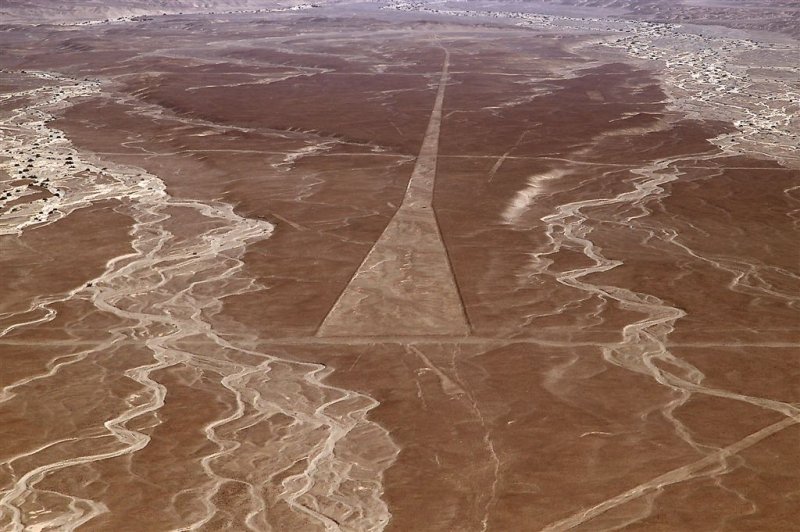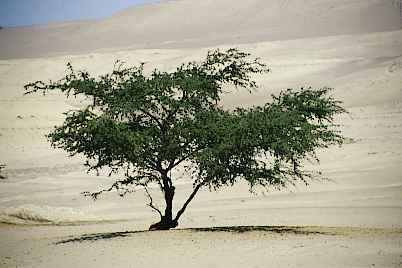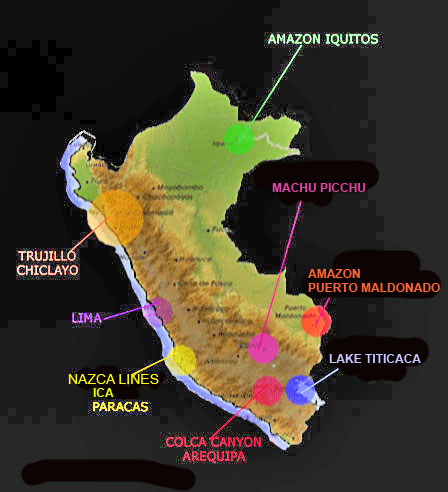Ancient Nazca Civilization Committed Fatal Ecological Error
posted on November 8th, 2009 in Archaeology, Environment, Peru, Recent Discoveries
Logging Caused Nazca Collapse
BBC News
November 2, 2009
The ancient Nazca people of Peru are famous for the lines they drew in the desert depicting strange animal forms.
A further mystery is what happened to this once great civilization, which suddenly vanished 1,500 years ago….
Now a team of archaeologists have found the demise of the Nazca society was linked in part to the fate of a tree.
Analyzing plant remains they reveal how the destruction of forests containing the huarango tree crossed a tipping point, causing ecological collapse.
The team have published their findings in the Journal of Latin American Antiquity.
A rare grove of huarango trees cling to an enormous sand dune near Ica, Peru
This remarkable nitrogen-fixing tree was an important source of food, forage timber and fuel for the local people.
“These were very special forests,” says Dr David Beresford-Jones from the McDonald Institute for Archaeological Research, University of Cambridge, UK who led the team.
The huarango tree (Prosopis pallida) is a unique tree with many qualities and played a vital role in the habitat, protecting the fragile desert ecosystem, the scientists say.
“It is the ecological keystone species in the desert zone enhancing soil fertility and moisture and underpinning the floodplain with one of the deepest root systems of any tree known,” Dr Beresford-Jones says.
The tree was also a useful resource.
“This remarkable nitrogen-fixing tree was an important source of food, forage timber and fuel for the local people.”
Researchers have previously found evidence that suggests the disappearance of the Nazca society was a due to catastrophic flooding event as a result of El Niño around AD500.
The location of the Nazca Culture in SE Peru
El Niño is a cyclical event that occurs as a result of a change in ocean temperatures that can cause a change in climate and severe flooding to the the west coast of South America.
The researchers have now found new evidence that suggests the society would not have been so easily destroyed if they had not cut down the forests around them.
Analyzing plant remains and pollen in soil 1.5m deep, the team was able to trace an important sequence of events which show the clearing of woodland for agriculture.
“At the bottom of the profile there is a lot of huarango pollen and little evidence of human impact,” explains Dr Alex Chepstow-Lusty from the French Institute of Andean Studies in Lima, Peru who also took part in the study.
“Then, at 80cm deep, maize pollen becomes common, showing the importance of this crop, suggesting a greater need for food and an increasing population,” he says.
“It is now we notice a big impact on the huarangos and a major decrease in their pollen.”
The landscape only became exposed to the catastrophic effects of that El Niño flood, once people had inadvertently crossed an ecological threshold.
“Then suddenly corresponding with the El Niño event at AD 500 or shortly afterwards, the pollen is dominated by weeds in the family Chenopodiaceae, which are adapted to salty conditions and this landscape is now the desert seen today.”
The Nazca are famous for creating complex line drawings that can only be seen from the air in the Nazca desert, Peru 400km south of Lima.
They were created between 500BC and AD500 and depict animals such as monkeys and whales as well as geometric figures several kilometers long.
As well as the lines, the Nazca also formed a sophisticated society, constructing complex irrigation systems for agriculture.
However, despite their skills and expertise, the researchers say the Nazca society inadvertently contributed to their own demise through the removal of the tree species.
Our research contradicts the popular view that Native American peoples always lived in harmony with their environment until the Spanish Conquest.
“The landscape only became exposed to the catastrophic effects of that El Niño flood, once people had inadvertently crossed an ecological threshold,” explains Dr Beresford-Jones.
“Such thresholds or ‘tipping-points’ are sharply defined in these desert environments.”
“Our research contradicts the popular view that Native American peoples always lived in harmony with their environment until the Spanish Conquest,” Dr Beresford-Jones says.
Dr Beresford-Jones explains that with sufficient huarango cover, El Niños were in fact not great disasters and actually created years of abundance replenishing water aquifers.
Once too much clearance had occurred the landscape was exposed to the effects of the El Niño floods.
“The river down cut into its floodplain and that floodplain narrowed hugely, irrigation systems were left high and dry,” he says.
“Human induced gradual change is just as important to the full story of Nazca collapse as the major climatic impacts that eventually precipitated them.”




